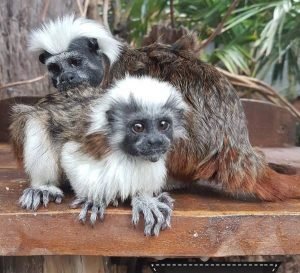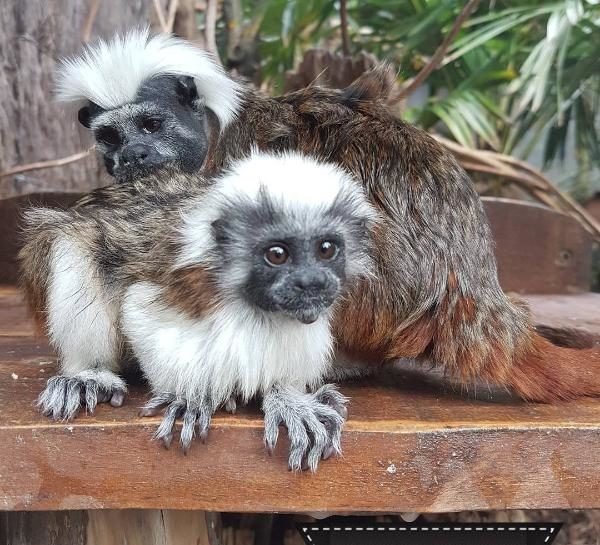- You have no items in your shopping cart
- Subtotal: $0.00
Buy Tamarin Monkeys
$1,300.00
Buy Tamarin Monkeys

Tamarin monkeys are squirrel-sized New World monkeys belonging to the genus Saguinus in the family Callitrichidae. They are the first offshoot in the Callitrichidae family tree, and are therefore considered the sister group to lion tamarins, Goeldi’s monkeys, and marmosets. Buy Tamarin Monkeys
Here are some key characteristics of tamarin monkeys:
- Size: They are quite small, with a body size ranging from 13 to 30 cm (5.1 to 11.8 in) and a tail length of 25 to 44 cm (9.8 to 17.3 in).
- Weight: They are lightweight primates, weighing from 348 to 575 grams (12.3 to 20.3 oz).
- Habitat: They are arboreal rainforest dwellers, inhabiting tropical rainforests and open forest areas of Central and South America, ranging from southern Central America through central South America, including northwestern Colombia, the Amazon basin, and the Guianas.
- Diet: Tamarins are omnivores, and their diet consists of fruits, insects, small vertebrates, bird eggs, nectar, and gum. Buy Tamarin Monkeys
- Social Behavior: They are highly social creatures, living in family groups of 2 to 8 individuals, with a dominant breeding pair. These family groups can sometimes come together to form larger troops of up to 40 members.
- Communication: Tamarins communicate through a variety of vocalizations, including chirps, trills, and whistles. They also use body language to communicate, such as tail flicks and facial expressions.
- Reproduction: Tamarins typically give birth to twins after a gestation period of around 140 days. The young are cared for by all members of the group, not just the parents. Buy Tamarin Monkeys
Here are some interesting facts about tamarin monkeys:
- Tamarin monkeys are known for their distinctive vocalizations, which have been likened to bird songs.
- They have sharp claws on all digits except the thumbs, which allows them to climb trees agilely.
- Some tamarin species have mustache-like facial hair. Buy Tamarin Monkeys
- Tamarins are an important part of the rainforest ecosystem as they help to disperse seeds.
- Unfortunately, habitat loss and the illegal pet trade are major threats to tamarin monkeys.
If you’re interested in learning more about specific tamarin monkey species, there are over 22 different ones! Some well known varieties include the cotton-top tamarin, the emperor tamarin, the Geoffroy’s tamarin, and the pied tamarin. Buy Tamarin Monkeys
Category: Monkeys For Sale
Tags: adopt a capuchin monkey for free, adopt a capuchin monkey uk, adopt capuchin monkey, baby capuchin monkey for sale in nc, baby capuchin monkey for sale london, baby capuchin monkey for sale uk, black capuchin monkey for sale, buy a capuchin monkey, buy a capuchin monkey uk, buy baby capuchin monkey for sale, Buy Capuchin Monkey, buy capuchin monkey canada, buy capuchin monkey in florida, buy capuchin monkey online, buy capuchin monkey south africa, buy capuchin monkey texas, buy capuchin monkey uk, buy pet capuchin monkey, Buy Tamarin Monkeys, Buy Tamarin Monkeys online, buying a capuchin monkeys as pets, capuchin monkey 4 sale, capuchin monkey adoption, capuchin monkey as a pet, capuchin monkey boo, capuchin monkey breeders in texas, capuchin monkey breeds, capuchin monkey brown, capuchin monkey buy i, capuchin monkey cage, capuchin monkey can you buy, capuchin monkey cost, capuchin monkey diet, capuchin monkey documentary, capuchin monkey food for sale, capuchin monkey for adoption, capuchin monkey for sale dubai, capuchin monkey for sale dublin, capuchin monkey for sale edinburgh, capuchin monkey for sale germany, capuchin monkey for sale glasgow, capuchin monkey for sale gumtree, capuchin monkey for sale houston, capuchin monkey for sale in bahrain, capuchin monkey for sale in birmingham uk, capuchin monkey for sale in lebanon, capuchin monkey for sale kansas city, capuchin monkey for sale kent, capuchin monkey for sale uk, capuchin monkey for sale usa, capuchin monkey on sale, capuchin monkey to buy, capuchin monkey to buy uk, exotic capuchin monkeys for sale, Exotic Monkeys for sale, Exotic pets for sale, female capuchin monkey for sale, female capuchin monkey for sale uk, hooded capuchin monkey for sale, how much are capuchin monkey for sale, live capuchin monkey for sale, Monkeys for sale, real capuchin monkey for sale uk, Tamarin Monkey for sale, Tamarin Monkeys, Tamarin Monkeys for sale, Tamarin Monkeys for sell, Tamarin Monkeys on sale, Tamarin Monkeys online, Tamarin Monkeys pets shop, where to buy capuchin monkey pet, white capuchin monkey for sale, white headed capuchin monkey for sale, young black capped capuchin monkey for sale








Customer reviews
Reviews
There are no reviews yet.
Write a customer review